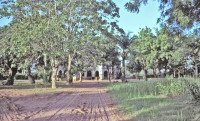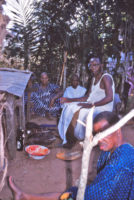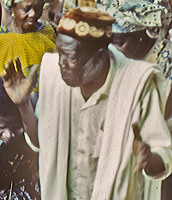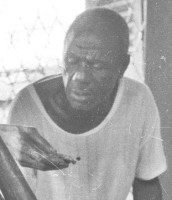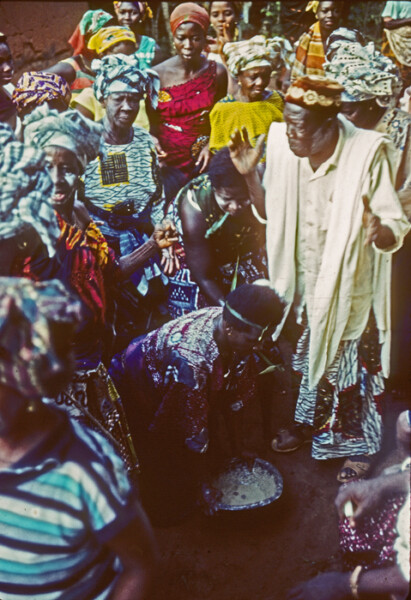Above: The Sons of Umu-EzeAroli arrive to witness Akukalia’s Ini-Ozu (Burial)
Note that this page provides some detailed description, aimed at showing some of the essential procedures of this primary, initial portion of what will become an elaborate two-stage funeral for a titled man. Here we deal only with the ini-ozu (lit., “burying the corpse”), which is all that I could record for Akukaliam(and that, indeed, very incompletely).. Other pages in this volume which are devoted to funerals — for example, “Oziziani…” focus on the second stage, “Lamentation”, (ikwa-oxu, lit. “crying for the corpse”). Unlike Burial, Lamentations tend to be joyous.
Also note that we will encounter here some political contestations. I will minimize most of these here, but the fact is that every Onitsha funeral entails political interactions and to some degree, struggles (and re-alignments of the groups involved). The disposition of the dead is to some extent a contest to redefine relationships among the living.
June 12, 1961.Byron Madulegbuna of Isiolkwe informs me that his patrilineal kinsman Akukalia Obiozo of Isiokwe Village has died. Since Akukalia was a substantial titled elder of the village, this event sets in motion an elaborate set of social activities with significant political implications. However, the circumstances of this particular Ozo man’s death are somewhat unusual: while Akukalia deserves full Ozo-sltatus respect, as a full-bodied person in life he was definitely deviant by Ndi-Ønicha standards: according to Byron, Akukalia, having taken and discarded more than nine wives, had failed to raise his sons properly: “each time he kicked them out he gave his sons the boot also”. While Byron often expresses his views of others quite sharply, this assessment suggests to me that we are dealing with an interpersonal history of a very unusual Onitsha man, and makes me suspect that the forthcoming process will not be entirely straightforward. (This assessmentr was by the way confirmed soon after this funeral,
We drive first to Isiokwe’s senior lineage priest (diokpala), Akunwafor Erokwu, who lives in a substantial mansion along the north side of Awka Road (where I am always intrigued seeing a small sign standing by the street entryway advertising a “Red Indian Witch Doctor” .) This house is just one of the fruits of his former role as an Onitsha Court Clerk during the early 20th century, a job that earned him much wealth, enabling him to take Ozo title at a young age and to retire early into a main focus on Inland Town affairs. Consequently, Akunwafor has become a prominent figure in Ndi-Onicha society.
Akunwafor and Byron discuss what must be done, Their primary concern is that money to finance the funeral events will be hard to raise, since Akukalia’s senior son is living in Lagos and has long been out of touch with members of his Descent Group in Isiokwe. Their first task is to consult with Akunne Obiozo (Akukalia‘s junior brother, who lives in Onitsha Waterside) and other members of Chimukwa section of Isiokwe (the descent group segment most closely invoved with the deceased.).
June 13.
Nobody questions Who the Head Mourner (Onye Isi-Ozu) should be for this occasion. Akunwafor Erokwu, Akunne Erokwu (one of Akunwafor’s junior brothers), and Byron all agree that the task is designated Akunne Obiozo. Says Victor (Akunne Erokwu), “the sons of Akukalia are young men, irresponsible, who don’t know Onitsha custom at all; only for that reason could they have refused to contribute (their share)” (which I gather he has heard they have done).
Ikposu Ozu (“Announcing the death”)
I go with Byron to the house of Akunne Obiozo in Otu, where he is addressing those assembled about mobilizing money for this funeral. I learn that he has himself already contributed £ 60 — but he is also expecting the sons of Akukalia to give their share and it appears that none of them are willing to do so, each of them claiming the others should donate first.(a comment reaffirming Byron’s assessment of the family situation).
As I consider the scope of this question of funding the funeral, I ask Byron and Akunne Erokwu what each of them will be giving to the funerary fund. They reply that it is not incumbent upon them to contribute — this is a task for the people of Obiozo’s section of the family. When I ask what would happen if he, Akunne Erokwu, dies, he says that, in that case, Obiozo’s section must contribute, since “they are under our section of the family, we are the Diokpala of Chimukwa” (branch of Isiokwe)”.
These funerary obligations are extremely complex in practice and to considerable degree they appear to remain uncertain until death occurs. For example, later this day Byron reveals that he needs £1 (which I am able to provide as he is momentarily penniless) as his contribution to this particular burial, because of the fact that since he is Nwadiani to Sam Obianwu’s family , and since Sam (a member of Ogbe-otu Village) is Moather’s People to Obiozo’s family, that means that Byron is in a meaningful way also Nwadiani to Obiozo (his fellow patrilineage-mate), and few obligations are more compelling than those binding Daughter’s Children and Mother’s People. (See Henderson 1972:129-30, 136, 424-7 for extended discussion of this relationship).))
At this point I begin to better grasp the deeply intertwined nature of Ndi-Onicha social relationships, where separated patrilineal descent groups are cross-cut by complex relationships connected through mothers (and daughters). These internal complexities greatly complicate the patterning of social obligations, and therefrore the calculations that must me made in deciding each party’s choice of social actions. This leads in my opinion to situations promoting a certain “cultural paranoia” on the part of some participants in the sociaty. (See Chapter Three, the page on “Power and Paradox.)
Byron goes on to observe that, when his mother (a Nwa-ada of Ogbeotu) and Byron’s father (a son of Isiokwe) planned to marry, they were first required to ritually kill a goat at the appropriate shrine because of their (somewhat distant) relations through mothers, and that thereafter people have tended to cluck about the productivity of this marriage –there having resulted in only two surviving sons,therefore the “inappropriate relationship” must have “stunted the marriage’s fruitfulness”. This is a chronic problem for those Ndi-onicha who are most deeply intertwined. (Byron says he thinks Akunne Obiozo has demanded this contribution from him in part because the sons of Akukalia continue to refuse to pay their share, and he is trying to widen his financial reach.) 1
In the evening, we proceed with the initial steps of Announcing the Death — beginning with Noteification of Illlness) by driving to Akunwafor‘s house in Isiokwe (as opposed to his mansion in Otu, where he normally resides). Nne-Mmanwu Erokwu (a very senior woman present) breaks kola for us, indicating a start of the process. After some time, Akunne, Byron, and I walk up the road to Akukalia‘s house, where we find a number of male Mother’s People (ndi-nne-ochie) to Akukalia assembled, including Sam Obianwu (of Ogbeotu), Nzekwu the Omodi (senior priest of all Umuasele (see his role during the 1961 Interregnum in “Bestowing Ofo” during the Interregnumm (recodrd in the image just above) , and also a number of women and some other Odoje people, all sitting outside (not within) the house, and we all wait there.
After a while, Akunwafor (Isiokwe Diokpala) appears, and recalls the three of us Isiokwe elders back to his Isiokwe residence, where he enters his attached ritual house and returns outside bringing two old, thoroughly-ritualized Ossissi staves. One he gives to his junior brother and fellow Ozo man Akunne Erokwu, who proceeds to spin the iron rings so they will jingle (the appropriate sound for mobile Ozo men to make, announcing their arrivals at a ritual event) as he strikes its base on the ground while walking toward the forthcoming moment of social significance. Akunwafor (whose staff-rings are stuck fast to the Ossissi body by so many accumulated dried blood offerings) ignores this impropriety of silence and strides forcefully ahead, in his relatively soundless but (as always) authoritative manner.
We now enter the “parlor” of Akukalia’s house, where seating arrangements are enacted. Akunwafor occupies the throne as the senior priest of Isiokwe Village. Various Isiokwe elders are present, along with two senior “Mother’s People” (nne-ochie) to Isiokwe: Nzekwu Omodi of Umuasele Village and Sam Obianwu of Ogbeotu Village. These latter are indispensible Witnesses to the process, taking motherly interest iin the welfare of their Daughters’ Children (in this case, Akukalia Obiozo).
Now the young men (the Umu-Ilo) of the Village begin to bring out Akukalia Obiozo’s “Idols”: several Okpulukpu (the Treasure Boxes are covered with thick coatings of dust, showing not a hint of regular blood sacrifices having beeen given them in the past), some ancient and also unbloodied Ossissi staves, one chi stick, his Okwachi (representing his Ozo-purified self,) but his Ikenga is nowhere to be found. For several minutes Akunwafor voices a demand to see the latter, but they eventually abandon the search. Nzekwu the Omodi comments disgustedly, “These idols have never tasted blood” (a devastating observation regarding Akukalia‘s status as a “Real (and titled)! Onitsha Man). All of this tells me that these spiritually-specific dimensions of Akukalia‘s self should be given their ritual due at the outset.
Nkata Umunna (“Notifying the descent group”)
Finally, an Umu-ilo Youth brings kola on a dish to Akunwafor, who breaks it by smacking it sharply on his Ossissi , placing the pieces in a small pile on the dish. Then he picks the sprouting seed out of each nut with his thumb, dropping it on the assembled Treasure Boxes. Now he calls Akunne Obiozo (who will act as the Head Mourner, Onye-isi-ozu) and gives him a piece of kola. Obiozo kneels and announces that he has learned that Akukalia Obiozo is seriously ill.
Akunwafor takes a piece of Kola, puts it in his mouth and chews it, then spits it out over all the assembled Ossissi and Okpulukpu, offering a vocal prayer to all the assembled ancestral potencies of Isiokwe to help their ailing comrade. Which particular ghostly names are vocalized (and which omitted) is (as Byron carefully reminds me) a signal measure of the status quo of descent group standing among those present.
A Youth then hands a gourd cup of palmwine to Akunwafor, who addresses it to the ghosts of Isiokwe. He calls for his favorites to come and take drinks, and then a sequence follows of multiple palmwine offerings by senior parties and respectful drinkings by their designated , kneeling subordinates. (Byron pokes me in the shoulder, emphasizing that “no man will call anybody to drink who is not a legitimate member of his family”, and those deemed illegitimate “will never dare” to call anyone from the other side. “I would only accept drink from a real Isiokwe man”, he whispers. Inclusion and (partial) exclusion are indicated by the patterning of choices everyone present can witness.
As this is happening, various people arise to speak to the gathering, presenting some current problem in the family, and in each case the address begins as follows: “Akunwafor, Akunwanne, [the two senior priests of major divisions of Isiokwe], Omodi, [a Mother’s People to Isiokwe family and a prominent Ranking chief], Akunne [Uwechia], Akunne [Erokwu],” etc.,etc., then after addressing all the titled men by their title names, the speaker either refers to the untitled men present by name, or simply sums unnamed others with the title honorarium, “Ogbuefi [“Cow-killer”], Ogbuefi, Ooooo.” (Untitled persons go un-named.) Then the speaker makes his observations to the group.
Palm wine offering then gives way to that of shot glasses containing Schiedham’s Schnapps (Gin), and I observe Akunwanne Bosah call one titled elder to take it. Byron pokes me again and observes, “No one else here will call [the person in question] because his ancestry is in doubt.” I responded, “Why then did Akunwafor Erokwu call me to take Gin?”, and Byron replies, “Because it is assumed that you are a citizen of the country you came from. There is no question that you might be a slave.” (Isiokwe Village, a very small unit in the whole of Onicha, bows to no other in its internal conflict intensities).
Ewu Izuzu (“goat for discussion”)
After this interlude of drinking, a young man of the Umu-Ilo brings forward a goat, held by a rope. Another brings a bunch of plantain leaves and lays them on the floor before the altar. The goat begins nibbling on these leaves, over which it will be slaughtered. Akunwafor says, “An important man of our family is ill. Let this goat die, instead of him. If someone is going to die, let it be a goat, an animal (anu) and not a human being (mmadu) and member of our family.” Several Umu-Ilo seize the goat and it struggles and begins baying desperately, while Akunwafor takes a knife, holds fast the animal’s ears with one hand and rapidly saws through its throat with the other, spraying the blood over the assembled Ossissi (of Akukalia and the titled men present) and Okpulukpu (of Akukalia’s ancestors).
(A noteworthy fact of the process is the prominence of Ossissi in the ritual. Meanwhile, the lineage Ofo, symbolically so emphasized in numerous discussions, is nowhere to be seen. Perhaps it is somewhere inside one or more of the Treasure Boxes, but nobody bothers to look for it.) This observation comes from the time of the ritual. Absence of a visible Ofo is a typical feature of most (but not all) 1960s descent-group rituals I observe.)
Then we all sit quietly while the Youths begin the tedious process of cutting up the goat. They cut around each leg, slice the skin down the middle, then skin it out, setting the pelt to the right of the Altar. Then they proceed to divide the meat: to the high-ranking Nwadiani; to the Ozo-titled men; to the untitled men. This arouses very little argument regarding division of the meat, though someone raises the question of whether I might be accorded a share from that of the Ozo men (a suggestion resolved in the negative). I observe that throughout the evening, Nzekwu the Omodi passes almost everything that he is given on to the untitled men sitting next to him, and so I do the same.
This meat-parceling absorbs nearly an hour, while participants go in and out. By the time it is finished, the Umu-Ilo have already cooked the goat’s liver and blood, which they now bring forth for everybody to eat. This is divided into five pans: one for the reigning Diokpala (Akunwafor), one for Akunwanne Bosa (Diokpala of the opposing segment in Isiokwe), one for the Omodi, one for the Ozo-titled men, and one for the untitled men. Akunne Uwechi complains: “Each titled man should be given a pan!” (but he is over-ruled).
At this time, Ogbu-Agu (“Leopard-Killer”) arrives. An untitled but socially dedicated and well-regarded Isiokwe man, he has been working on his farm and so received the news later than the others. He is now immediately given every offering previously shared: kola, palm wine, gin, meat, cooked liver. He then rises and addresses the group, reporting that the Umu-Ilo have come to him and complained about certain ritual monies that were confiscated from them at an earlier date, when they had misbehaved, demanding too large a share.
Byron moans quietly to me; Ogbuagu has “let the cat out of the bag”: the Umu-Ilo have previously warned Byron (their official leader and spokesman, since he reamains an unmarried man though he is pushing age 30), saying “We are going on Strike! We will not dig the grave or carry the corpse unless we get our [confiscated] share!” Byron has been planning to beg for their interests once the Death is announced, but now Ogbuagu has blundered in, and meanwhile, outside, the Umu-Ilo are vocally refusing to dig the grave (though the fact of death has not yet been announced)..
Akunwafor, hearing Ogbuagu voicing their threats, says, “Oh-Oh-Oh [a high sing-song call indicating inappropriate behavior], so these men want this man to die!” The Ozo men quiet Ogbuagu, but the peaceful moment has passed, and Akunwafor, muttering, rises from his throne-seat, takes up his Ossissi and the others follow, stamping their staves on the floor as they walk outside. There, several Umu-Ilo confront Byron as we exit, and they begin to argue.
Later I learn his story: sometime last year, the Umu-Ilo misbehaved in a ritual for which the share due them was £ 7; they demanded more, and the elders responded to this insubordination by confiscating the entire amount. Since then, the elders have continued withholding the Youths’ due, while the latter could do little in response until now (the first death in Isiokwe since the conflict began), and their tactic now is to refuse even to carry the corpse.
Nkata Umunna (notifying the descent group)
As they stand arguing and the elders stroll away, Akunne Obiozo reappears, calling out to everyone: “Please, come back, there are new developments!” Instead of changing course, the titled reply, “Wait until we have taken our Ossissi to their resting places.” (The Ossissiˆmay not be present for the next phase of the ritual.)
Soon the elders return and re-enter Akukalia‘s house (which in the meantime has been cleaned out, no goat blood or palm fronds remain on the floor) andthey again sit down around the altar. Now the Nne-ochie have departed (their presence in “looking out for” their Daughter’s Child’s welfare is no longer relevant). We sit for a while as Akunwafor tells some irrelevant tales. Then Akunne Obiozo reappears, presents a dish containing some money upon the altar, and announces that his brother has died. Akunwafor sings a soft chant (words I can’t make out), as Akunne deposits some more shillings into the dish. Then he begins verbally accosting some of the Youths who are present, and Byron as their Elder Spokesman kneels down before the alter and apologizes on their behalf to the elders, passionately regretting their various recent misbehaviors.
As this is happening, some twenty cannon shots are fired, reverberating through the nearby bush.
The elders now file out of the house, where the Youths again accost Byron, demanding he take their side more strongly. Akunne Obiozo approaches and emphasizes that he will “demand an accounting of Odoje“, a comment I do not quite understand,but it is clear that Odoje Village Youths are definitely partners required to participate in funerals involving Isiokwe people. The Youths present say, in effect, “This is a waste of our bloody time”, and walk away, just as a station wagon arrives on the scene, bearing the corpse. Isiokwe (and Odoje) Ikporogbe (Village Wives) and Umu-Ada (lineage Daughters) who have assembled around the yard begin their loud wailing (“Ewo, Ewo….”), and Byron in desperation runs off seeking someone to help him carry the corpse inside the house.
Some young men and women (Nwadiani? Umu-Ada?) hastily set up a bed in the main parlor, where we have recently re-gathered. Simultaneously women begin to arrive in large numbers, bringing pans of foo-foo (pounded yam food) covered with palm leaves. Some enter directly into the Death Room, others go into other rooms. Each woman who enters the former first sets her pan on the threshold, hesitates as though awaiting an invitation to enter, then does so with her food.
Women come walking down the street, now, women from other sub-villages in Odoje, wailing and sobbing in their very standardized way in the darkness, summoned by the sound of the cannons.
igba izuzu (dance of anger)
And now Odoje men also arrive, summoned by the Ekwe drum. Some of them join the efforts to arrange the bed for the corpse, but most gather in front of the Death House and begin to dance around the Village, singing our their anger that one of their senior men has died (Igba izuzu).
As they depart, a large number of women have gathered (nearly a hundred), some sitting outside of the Iba, sewing and arranging the white cloth which they are preparing, elaborate covering for the bed for the corpse and to cover the doors and the windows in the room where the corpse is placed. Some of the women sewing call out demands for [Guinness] stout.
By 9:45 pm, around 40 young men from Odoje have arrived to work over the bed and the corpse. One woman brings in the Ogene drum and starts beating it, walking about the room, then stopping to beat the drum. Then eight Wives of the Village (Ikporogbe) begin do dance in a circle, more and more joining them, some periodically moving to the centre of the circle.
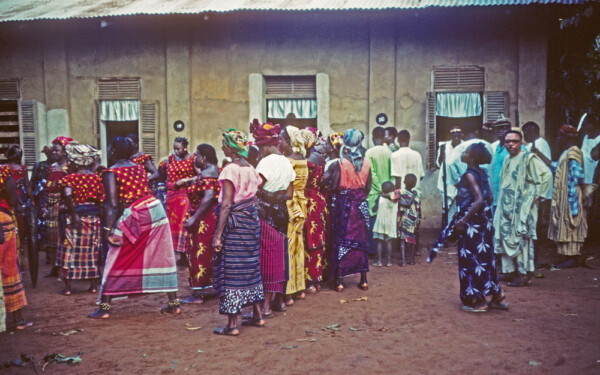
Several groups of women were dancing. One of them, the Wives of the Village (ikporogbe) included Helen, I was told, but I didn’t get the opportunity to see her.
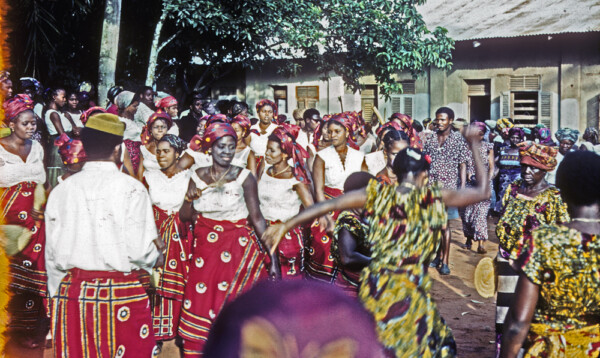
Later, outside, some Odoje men return from their Anger Dancing, brandishing sticks they have grabbed from bushes along their route, and as the Ekwe beats they sing “modimas ogene, modimas ogene….“, as they dance in a large circle. A newcomer enters, dances, becomes inspired, runs to a nearby bush fence and viciously rips out a wooden staff, returning into the group with a loud whoop. The circle is mainly male now, but as spirits run high some women join in to dance within the circle, one now holding the horsetail switch (Otinri), while some of the men wave machets and knives. Akunne Obiozo moves into the center of the dance group, as men begin to clack their matchets and staffs together, moving more violently. At one point, two men hold a single staff horizontally between them with both hands.
Some of the men appear to lose self-control and charge about the arena while the Ekwe drum is beating. (Byron later tells me that in the old days, the men might well pull down the house and many of the trees around it; “They would just go berzerk, you know!”)
Now some of the Odoje Ikporogbe dance, others begin carrying the prepared white cloths into the room. Some young men have wrapped white cloth around their heads, and they begin to dance, clowning around with the female dancers, as all sing out their anger that an important member of their community has died. While they dance, sons and daughters of the deceased walkd around, giving money to the dancers.
While the Odoje women were accompanied my several male clowns were active, the, Odoje elders are off in another compound preparing their own dance. Just as they approach, a slight rain begins to fall, and Byron observes, “This is very significant!”
As the Odoje men came, this time carrying the Ijele drum, they mixed withy the Ikporogbe Isiokwe and Umuada (Ogboli Olosi, I am told, instead uses at this stage a drum called Abiolo, which has a different sound). Everybody, young and old, men and women were dancing in this circle. Finally it all ended and everyone went home.
June 14, morning
On this second day, in the morning, it rains very heavily — a violent rainstorm blows rain all over the Inland Town. A number of people comment about the fact that Isiokwe are rainmakers, and produced this rain as their own tears. They are crying for the deceased.
Later in the morning, Akunwafor, as Okpala of Chmukwa, has to go up and pay his respects to the deceased, by taking an eagle feather and sticking it into the corpse’s hair. As we discovered when entering, the Umuilo, despite all their threats, have gone on to dig Akukalia’s grave. Victor ERokwu called their bluff, sayng he would hire laborers to do it. We enter the room; all the Umuada are sitting arounnd the corpse. Each of us, after Akunwafor applies the eagle feather, drops some shillings into a pan held by the Umuada.
At this moment, the Umuada are preparing for the ritual of the “Breaking of the Pot”, which no man is allowed to observe. Hence we miss it, Helen being absent.

The Daughters of Odoje cleanse the feet of Isiokwe men with white clay, to ease their paths forward. Here, Ozomma Albert Erokwu awaits his turn while Akunwafor is given the blessing. Byron Maduegbuna looks on at lower right.
And below,, I too receive the treatment. Note that two of the women hold a green leaf in their mouths. This is a sign of their distinctive (and dangerous) sdpiritual condition, having recently touched a human corpse.

I experienced this as a real gesture of respect to me, and was both surpriised and deligthted to be included. (Later that month, akunwafor Erokwu saluted me as “A real Onitsha man, and an Isiokwe man at that! ” This was a high point in my experience in onitsha.)
Then, abruptly, there was the appearance of a very large contingent of well-dressed and many prominent men of Umu-Eze-Aroli. This included the Chief, Chude Adazie at far left and Michael Enwezor (with dark glasses and yellow Agbada) at right. Obiekwe Aniweta, also in yellow, raises a fan as he walks to Michael’s right.
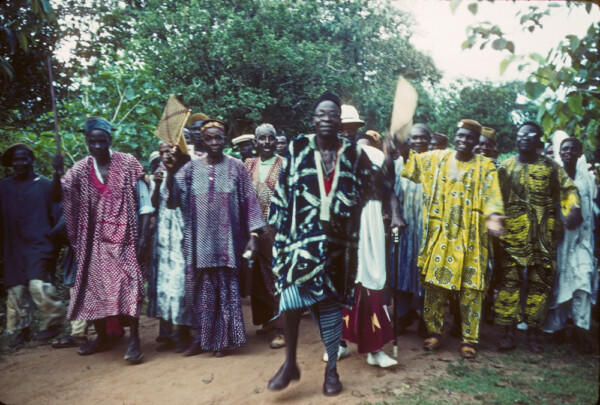
This was a very impressive group indeed, far larger than might have been expected (given the fact that a great many funerals were being held at this time, placing constraints on time for many).
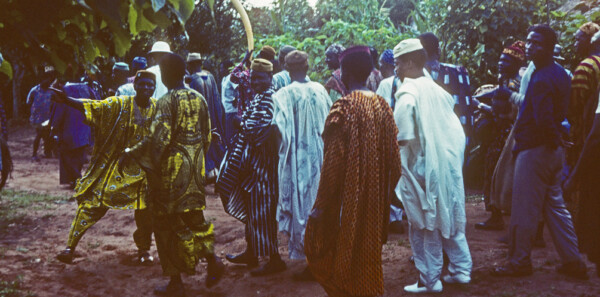
I recognized immediately that there as an important sub-text to this very impressive gathering. In the High court of Onitsha, Judge Betuel had very recently decided a land case that Umuezearoli had brought against Isiokwe, claiming they had rights to some parts of Isiokwe land.,j in Umuezeaaroli’s favor, based on a technicality that found fault with an Isiokwe map.
I had met Judge Betuel, admittedly very brief enocounter at one of the fiew “local elite” parties that Helen and I had attended, and had learned from that exchange that he appeared to know very little about Onitsha descent groups and relationships. In this case I also knew that some “cultural experts” of UmuEzearoli had come up with what local historian Jerrry orakwue would have called a “new history”” (See Chapter 5, the page on “Newspapers and “cultural brokers” that discusses this culture-creation phenomenon), claiming that the youthful Aroli, upon his arrrival at Onitsha from Igala in prehistorical times, had lived for some time in Isiokwe prior to establishing himself in the vicinity of Okwu-Eze, the Sacred Grove of the sequence of Umuezearoli kings. This was a very new idea with no previous accounts proposing it. Moreover, I knew that Umuezearoli’s own maps were copies of those originally made by Isiokwe people fora peivious land case against Obosi people, So it seemed odd that an Isiokwe map should have been the problematic one in this case.
Later, I observed that Judge Betuel’s wife was the only non-African person (beside myself) to attend Igwe Enwezor’s crowning (See Chapter Six, page on “The Onowu crowns an Obi”), which made me wonder if Igwe Enwezor’s lavish expenditures in, around, and beyond UmuEzeAroli might have extended into an interest in the outcomes of this court case.
Of course, I shouldperhaps admit to bias in this case, since I am an “Isiokwe man” myself.
Umuezearoli brings forth their Long Juju
In the culmination of the burial of a titled man, the mmuo-ogonogo (“Tall Ghost”) appears, and escorts the deceased to the Land of the Dead. Below, you can see Michael Enwezoer is one of the elders accompanying the Ghost as it marches forth on its journey.

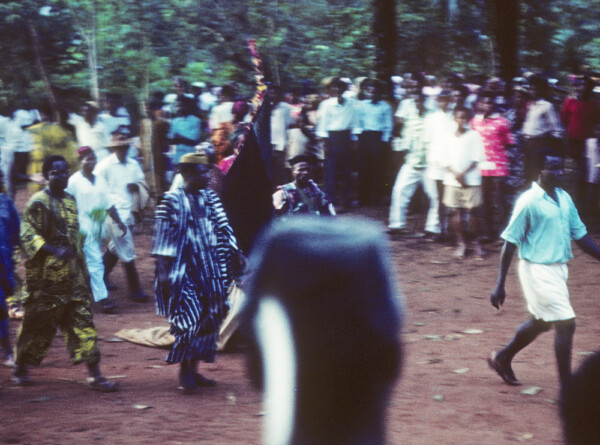
The light was poor and I was standing at a distance, but this was the only time I had an opportunity to photograph this fabled being, so I made numerous efforts to do so.

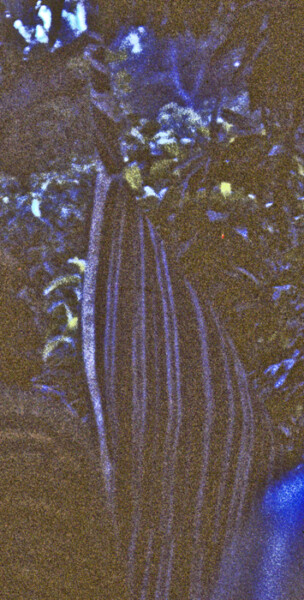
I succeeded only poorly, but it was worth the effort, watching the Tall ghost disappear with its fellow-traveler into the darkness.
- While they are discussing these issues, Byron observes that Akukalia “may have done something” in connection with the death of Owelle Obianwu (Byron’s mother’s father and a major figure in recent Onitsha history), which occurred last year around this same date. Byron adds that someone has already told him “It is very interesting” that Akukalia has died almost exactly a year after the Owelle‘s own death. At one point earlier today, Byron stated flatly that Akukalia “killed the Owelle“, but now he equivocates: “Akukalia did bring rain” (to the Owelle‘s funeral), and it was spoiling the event, so the Owelle’s sons went to him and asked him to desist; he refused unless they gave him £50 and a carton of schnapps (an outlandish suggestion which they declined). So Byron and Odu Mbanefo (Senior Chief of Odoje, the major village of which Isiokwe is a part) then tried to dissuade him, but he refused to change his demands. (Akunne Erokwu shakes his head at this entire report,, saying “Oh, this is very bad!”) [↩]

